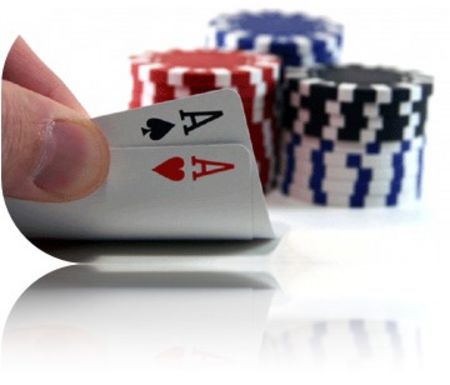Betting or Raising as a Bluff

As we discussed earlier, one of the worst mistakes you can make on the river is
folding the best hand. On the other hand, getting an opponent to fold the best hand
is a great achievement since you win the entire pot. The most common example of
a bluff bet on the river is when you are on a draw and you bet hoping that your
opponent is on a busted draw also or will fold a weak pair.
For example, you raise in late position with the 9 ♣ 8 ♣ and the big blind calls. The
flop is J ♦ T ♦ 5 ♣. The big blind checks and calls to you on both the flop and turn and
now checks again on the river. A bet here is correct against most opponents. Your
opponent could be on a flush draw or a straight draw with AQ, KQ, K9, or Q9. You
are probably getting sufficient pot odds that your opponent will fold.
Be careful on who you try to bluff on the river. Bluffs are generally more successful
against strong opponents who are capable of folding a weak hand such as middle
or bottom pair. Most weak players tend to call with anything. Determining whether
to try a bluff on the river is simply an exercise of comparing the pot odds versus the
probability that your opponents will fold.
Bluff raises on the river are generally not profitable, as it is difficult to get an
opponent to fold who has already bet on the river, and you have reduced pot odds
on your raise.
Internet Tip
On the Internet, bluff raises on the river are even less successful than in a live game. Your
opponents have a tremendous curiosity to see your cards. They also realize that opponents on the
Internet try a lot of tricky plays, so they are more willing to call. Bluff raises usually are only
successful if you catch a player trying a bluff also, or you are against a very strong player who has
the ability to throw away a good hand. Weak players will almost always call a raise on the end with
any kind of hand, unless they were bluffing also.
However, there are times when you can identify an opportunity to successfully bluff
raise on the river. Here is a hand in a $20-$40 game where I was fortunate that my
opponent did not try a bluff raise. I had AA in the big blind. An early player called, a
middle player raised, the button called, I reraised, the early player called, the middle
player capped, and everyone called. There was $330 in the pot.
The flop was 5 ♥ 3 ♦ 6 ♥. I decided to check the flop and wait until the turn to try a
raise so that I would have a better chance of driving out some opponents. The
middle player bet and everyone called, The turn card was the 9 ♠. I checked to the
middle player who bet, the button called, and I raised. Everybody called and the
button was all-in at that point. There was $730 in the pot. The river was the dreaded
J ♥. This card was terrible for me, as now a flush was likely, or possibly the middle
player hit a set. I checked. The early position player bet and the middle player
decided to call.
I was fairly confident that the early player had a flush since he called a raise cold on
the turn, but I still called since I was getting over 20 to 1 pot odds. The early player
showed A ♦ 7 ♦ and the middle player QQ.
I only bring up this example because- the middle position player saved the pot for
me. If he had raised the river, I would have folded since my pot odds would have
only been 10 to 1 and all the action indicated a flush or possibly a set. The middle
position player could have risked $40 more by raising to drive me out of the pot,
hoping that the early position player did not have the flush.
A scare card on the river can improve your chances for a successful bluff. For
example, a suited card falls, or the board pairs and you represent trips, or an ace
comes on the river and you represent the ace. These kinds of plays can work
against strong opponents because they have the ability to throw away hands on the
river when they think they are beat; however, these types of plays rarely work
against weak opponents as they almost always call.
NEXT..
The Worst Bet in Poker

